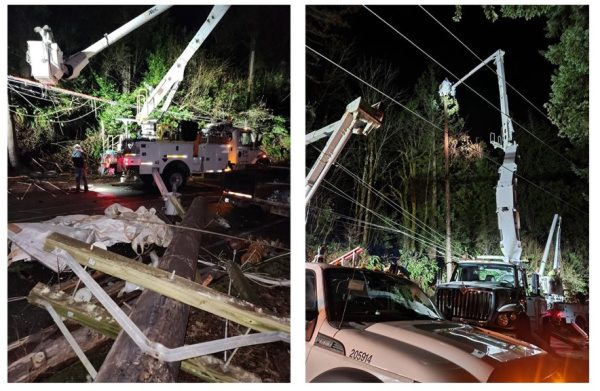March 31, 2025
How PSE restores your power after a major outage
In late February, a wind storm swept through PSE’s service area and took out power for nearly 250,000 customers. Bainbridge Island, in addition to the rest of Kitsap County and Vashon Island, were the hardest hit. Over 49,000 customers lost power in these areas. Saturated soil and strong winds uprooted heavy trees, causing significant damage to our infrastructure and access issues for our repair crews.
We know being without power, especially for extended periods, is incredibly challenging. We wanted to give you a more detailed look into our power restoration process and why it can take a while.
Here are the steps PSE takes to restore your power during a major outage event:
- Beginning of the outage event
- Regional storm bases and our Emergency Coordination Center open to support crew and resource coordination, response strategy and internal and external communication. Bainbridge Island is served out of PSE's Western Storm Base located in Poulsbo.
- During the February outage event, PSE brought in an additional 45 line crews to support quicker restoration. PSE often brings in resources from other regions and states to help when outages are widespread and damage is extensive.
- Assessing damage
- As soon as it’s safe to begin field activities, our damage assessors drive to reported outage locations across our service area to identify safety hazards (e.g., downed power lines), assess the severity of the damage and report back on the types of crews and equipment needed to restore power.
- Often, they face logistical challenges such as downed trees and debris blocking roads and neighborhoods. Our crews must clear these areas before they can then move in to begin damage assessment and restoration work. During major outages, damage assessment can take multiple days to fully complete.
- Establishing a storm response plan
- Based on the damage assessment information, the storm bases and Emergency Coordination Center determine resources needed, outage restoration prioritization and other response strategies.
- During the February wind storm, PSE deployed additional resources to the Kitsap area. At the height of the outages, there were 82 line crews working in the Kitsap area (typically we'd only have 4-6 crews).
- Prioritizing and restoring power
- First, repair crews focus on restoring power to high-voltage transmission lines, which are the superhighways of electricity, serving thousands or hundreds of thousands of customers. This process can be time-consuming because transmission lines often cover long distances and can be in hard to access locations. Priority is also given to essential services such as hospitals, water/waste water systems and transportation.
- Next, crews restore power to distribution substations, which give us linking and switching capabilities to reroute power around damaged areas. Once power is restored to a general area, crews can repair downed or damaged wires between utility poles and homes and businesses.
- To make repairs, crews may need many different pieces of equipment like augers to install new utility poles and bucket trucks for stringing new power lines.
- Our crews and outage response personnel work around the clock until all customers have their power restored.
- Our projects on Bainbridge Island will help prevent and reduce the duration of outages caused by storms like this one.
- With the Winslow Tap 115kV transmission rebuild, we are replacing aging infrastructure, improving vegetation management throughout the corridor to prevent trees from falling into the line and installing new gravel accesses to allow for faster and safer restoration during outage events.
- With the new Murden Cove- Winslow 115kV transmission line, we will connect the Murden Cove and Winslow substations. This builds redundancy into the system by creating a transmission "loop". The Murden Cove and Winslow substations will each be connected to two transmission lines (versus one). If one of the transmission lines goes out, the other transmission line can still feed the substation and provide power to customers while crews make repairs.
